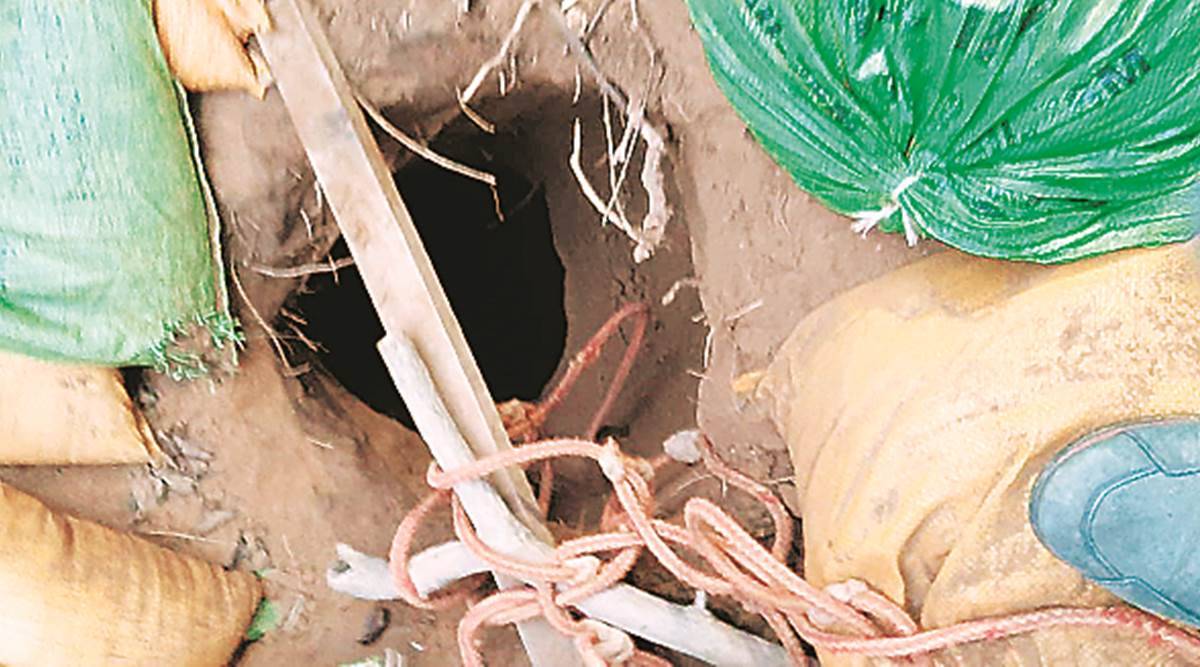
SOURCE: ENS
WHEN SECURITY forces tracked a GPS device recovered from the four Jaish terrorists who were gunned down in Jammu’s Nagrota on November 19, they reached a narrow opening that led to a 200m-long tunnel near a BSF outpost in Samba sector.
The discovery did not take them by surprise. This was the sixth tunnel that the BSF had discovered in the past four years along the Jammu border. And since the first such construction was spotted in Punjab in 1997, in the aftermath of the Khalistan movement and the beginning of militancy in Kashmir, BSF records show the discovery of at least 12 key cross-border tunnels.
Officers say that with tight border surveillance in place now, these tunnels have become a crucial route for militants carrying arms and ammunition to launch attacks in the Valley. “Detecting tunnels on a 200-km border with considerable foliage and creeks is not easy,” former BSF IG Rakesh Sharma, who has held command in the Jammu sector, told The Indian Express.
The latest tunnel was three feet wide and four feet high, with the small opening reinforced with sandbags. Security forces recovered 11 AK assault rifles, 24 magazines and 7.5 kg of RDX along with 20 m of IED wire and six detonators from the slain militants. They also found one Under Barrel Grenade Launcher, 29 grenades, five rifle grenades, three pistols with six magazines, a wireless set — and the GPS.
The previous discovery happened in the Galar area of Samba sector on August 27, when the soil around the spot began sinking. Just days earlier, the National Investigation Agency (NIA) had said in a chargesheet that the Pulwama attackers of February 2019 had used a tunnel on the Jammu border.
“Intrusion over ground has become difficult since a robust anti-infiltration grid, involving trained and alert manpower and state-of-the-art technology, has taken shape in the past decade. That is why terrorists now use subterranean methods,” said former IG Sharma.
According to BSF officers, the first such route to be discovered was on March 12, 1997, in Punjab, when the 70th Battalion discovered a 116-ft-long tunnel of two-and-a-half-feet diameter in the Amritsar sector.
The next year, a similar tunnel was spotted in the same sector. And the year after, a more elaborate tunnel, 170m long and three feet in diameter, was found in Gurdaspur. Another tunnel was found in 2001 near Chountra, also in Gurdaspur, which was 90m long and three feet in diameter. The last tunnel in Punjab was discovered in 2003 in Ferozpur, with a length of 50 m and height of just two feet.
“Those days, tunnels were not very deep and did not have enough space. Anything less than three feet high will force you to crawl, which can become difficult over distances,” said a senior officer.
According to Intelligence sources, these tunnels were initially dug by a Pakistani gold and narcotics smuggler, Jacka Masih alias Jacka Isai. “But he was later roped in by Pakistani forces. Even now, we find his signature on some tunnels. But modern-day tunnels, largely found in Jammu, have signs of engineering inputs by Pakistan Rangers,” the officer said.
On July 22, 2012, the BSF stumbled upon the first tunnel along the Jammu border, at Chillayari in Samba. According to officers, it remains the most “sophisticated” tunnel found so far — 255m long, 2.5 ft wide and 5 ft high, enough for infiltrators to walk across. It was dug at a depth of 25 feet and reinforced with wooden planks, with small pipes leading to the surface for air.
“It had clearly been made by engineers of Pakistan Rangers. Thankfully, we detected it while it was still unfinished. It appeared to be an attempt to make a permanent tunnel,” an officer said.
“The Punjab border got fenced in the wake of the militancy in the 1980s, but the Jammu border was not. So, through the peak of Kashmir militancy, you could just walk across if you managed to hoodwink the patrol. But once the Jammu border was fenced, tunnels became a resource for infiltration,” another officer said.
The next tunnel, 50 ft long but just two feet high, was found in Jammu in 2016, followed by a similar discovery the same year. Two small tunnels were discovered in 2017 and, after a gap of three years, two more in 2020. “The last two were more sophisticated… Most tunnels are found in the Samba sector because of the bushy terrain. Due to the abundance of creeks, the soil is soft and makes digging easier,” said an officer.
Over the years, the Jammu border has been reinforced with anti-infiltration checks, such as flood lights, thermal imaging cameras, laser beams over creeks and high-resolution surveillance. “But there is no technology to detect tunnels,” said a senior officer.
Following the 2012 discovery, the Ministry of Home Affairs tested tech to track tunnels. “An Israeli company’s ground sensors were tried out. The company claimed it could detect seismic vibrations. But we found it was effective only up to a depth of one-two metres,” an official said.






